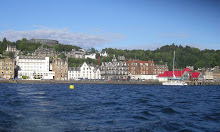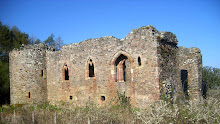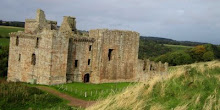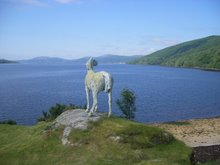... and a cup of tea at nearby Logie Steading, where there is a particularly good second hand bookshop. I fell prey to a book on Scottish surnames, a volume of Nigel Tranter's Fortified Houses of Scotland, and the book that has kept me engrossed for the past several hours, Ronald W Clark's Balmoral. No wonder Queen Victoria fell in love with Scotland when she visited first in 1842!
 At Dunkeld the Royal Party was met by the Atholl Highlanders, armed with the Lochaber axe. Received in an immense marquee, they were regaled with a gargantuan menu, a display of Highland sword-dancing and a taste of Atholl Brose. Taymouth Castle took things to a higher level. The firing of the guns," Victoria recorded in her Journal, "the cheering of the great crowd, the picturesqueness of the dresses, the beauty of the surrounding country, with its rich background of wooded hills, altogether formed one of the finest scenes imaginable. Lord and Lady Breadalbane took us upstairs, the hall and stairs being lined with Highlanders". If anything more were needed, dusk brought not only fireworks but 'Welcome Victoria - Albert' spelled out in hundreds of oil lamps, and the blaze of bonfires from a dozen nearby summits" .
At Dunkeld the Royal Party was met by the Atholl Highlanders, armed with the Lochaber axe. Received in an immense marquee, they were regaled with a gargantuan menu, a display of Highland sword-dancing and a taste of Atholl Brose. Taymouth Castle took things to a higher level. The firing of the guns," Victoria recorded in her Journal, "the cheering of the great crowd, the picturesqueness of the dresses, the beauty of the surrounding country, with its rich background of wooded hills, altogether formed one of the finest scenes imaginable. Lord and Lady Breadalbane took us upstairs, the hall and stairs being lined with Highlanders". If anything more were needed, dusk brought not only fireworks but 'Welcome Victoria - Albert' spelled out in hundreds of oil lamps, and the blaze of bonfires from a dozen nearby summits" . |
| Taymouth Castle |
So we should indeed be grateful to the Duke and Duchess of Atholl and Lord and Lady Breadalbane for their wonderful display of Highland hospitality. Without them and the Queen's resulting decision to buy Balmoral Castle unseen, those three great icons of our culture, Tartan, Bagpipes and Whisky, would never now be recognised worldwide.





























































